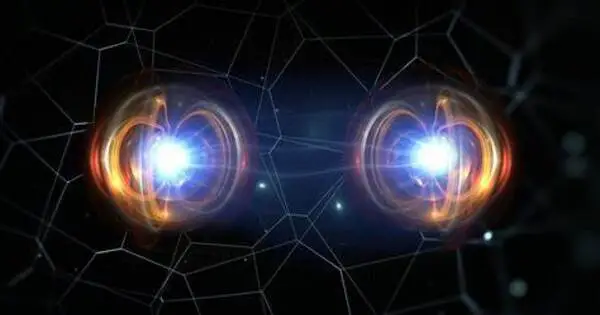Quantum entanglement is a quantum physics phenomena in which the states of two or more particles become correlated in such a way that the state of one particle can instantly impact the state of another, regardless of their distance. Topology, on the other hand, is the study of the features of space that are conserved under continuous deformations such as stretching or bending. Researchers have demonstrated an extraordinary capacity to perturb pairs of spatially dispersed yet coupled quantum entangled particles without affecting their common features.
For the first time, researchers from the Structured Light Laboratory (School of Physics) at the University of the Witwatersrand in South Africa, led by Professor Andrew Forbes, have demonstrated the remarkable ability to perturb pairs of spatially separated yet interconnected quantum entangled particles without changing their shared properties.
“We achieved this experimental milestone by entangling two identical photons and customizing their shared wave-function in such a way that their topology or structure becomes apparent only when the photons are treated as a unified entity,” lead author Pedro Ornelas, an MSc student in the structured light laboratory, explains.
We achieved this experimental milestone by entangling two identical photons and customizing their shared wave-function in such a way that their topology or structure becomes apparent only when the photons are treated as a unified entity.
Pedro Ornelas
This connection was made possible via quantum entanglement, also known as’spooky action at a distance,’ which allows particles to influence each other’s measurement outcomes even when separated by substantial distances. The findings were published in Nature Photonics.
In this work, the role of topology and its ability to preserve properties can be compared to how a coffee mug can be reshaped into the shape of a doughnut; despite the changes in appearance and shape during the transformation, a single hole – a topological characteristic – remains constant and unaltered. The two things are thus topologically equal. “The entanglement between our photons is malleable, like clay in a potter’s hands, but during the moulding process, some features are retained,” Forbes said.
The nature of the topology investigated here, termed Skyrmion topology, was initially explored by Tony Skyrme in the 1980s as field configurations displaying particle-like characteristics. In this context, topology refers to a global property of the fields, akin to a piece of fabric (the wave-function) whose texture (the topology) remains unchanged regardless of the direction in which it is pushed.

Since then, these ideas have been realized in modern magnetic materials, liquid crystals, and even optical equivalents employing traditional laser beams. Skyrmions are highly acclaimed in condensed matter physics for their stability and noise resistance, which has led to revolutionary advances in high-density data storage systems. “We aspire to see a similar transformative impact with our quantum-entangled skyrmions,” according to Forbes.
Previous study suggested that these Skyrmions were concentrated in a particular region. “Our work presents a paradigm shift: the topology that has traditionally been thought to exist in a single and local configuration is now nonlocal or shared between spatially separated entities,” Ornelas said.
Expanding on this concept, the researchers utilise topology as a framework to classify or distinguish entangled states. They envisage that “this fresh perspective can serve as a labelling system for entangled states, akin to an alphabet!” says Dr Isaac Nape, a co-investigator.
“Similar to how spheres, doughnuts, and handcuffs are distinguished by the number of holes they contain, our quantum skyrmions can be differentiated by their topological aspects in the same fashion,” says Nape. The team hopes that this might become a powerful tool that paves the way for new quantum communication protocols that use topology as an alphabet for quantum information processing across entanglement based channels.
The findings revealed in the article are critical since academics have struggled for decades to establish strategies to sustain entangled states. The fact that topology remains preserved even as entanglement decays offers a potentially novel entanglement-based encoding strategy, even in conditions with limited entanglement where existing encoding protocols would fail.
“We will focus our research efforts on defining these new protocols and expanding the landscape of topological nonlocal quantum states,” said Forbes.





